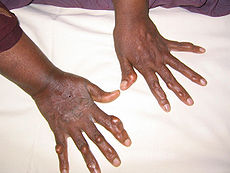- Xanthoma
-
Xanthoma Classification and external resources 
Photograph of patient's hands showing multiple xanthoma tendinosum. Kumar et al. Cases Journal 2008ICD-10 E78.2 (ILDS E78.280), K13.4 ICD-9 272.2 DiseasesDB 28524 eMedicine derm/461 MeSH D014973 A xanthoma (pl. xanthomas or xanthomata) (condition: xanthomatosis), from Greek xanthos, ξανθος, "yellow", is a deposition of yellowish cholesterol-rich material in tendons or other body parts in various disease states.[1] They are cutaneous manifestations of lipidosis in which there is an accumulation of lipids in large foam cells within the skin.[1]
They are associated with hyperlipidemias, both primary and secondary types.
Tendon Xanthoma are associated with Type II hyperlipidaemia and chronic biliary obstruction.
Palmar xanthomata and tuboeruptive xanthomata (over knees and elbows) occur in Type III hyperlipidaemia
Contents
Types
Xanthelasma
Main article: XanthelasmaA xanthelasma is a sharply demarcated yellowish collection of cholesterol underneath the skin, usually on or around the eyelids. Strictly, a xanthelasma is a distinct condition, only being called a xanthoma when becoming larger and nodular, assuming tumorous proportions.[2] Still, it is often classified simply as a subtype of xanthoma.[3]
Xanthoma tuberosum
Xanthoma tuberosum is characterized by xanthomas located over the joints.[1]:530
Xanthoma tendinosum
Xanthoma tendinosum (also known as "Tendinous xanthoma"[4]) is clinically characterized by papules and nodules found in the tendons of the hands.[1]:531
Eruptive xanthoma
Eruptive xanthoma (ILDS E78.220) is clinically characterized by small, yellowish-orange to reddish-brown papules that appear all over the body.[1]:531
Xanthoma planum
Xanthoma planum (ILDS D76.370), also known as "Plane xanthoma", is clinically characterized by macules and plaques spread diffusely over large areas of the body.[1]:531
Palmar xanthoma
Palmar xanthoma is clinically characterized by yellowish plaques that involve the palms and flexural surfaces of the fingers.[1]:531 Plane xanthomas are characterised by yellowish to orange, flat macules or slightly elevated plaques, often with a central white area which may be localised or generalised. They often arise in the skin folds, especially the palmar creases. They occur in hyperlipoproteinaemia type III and type IIA, and in association with biliary cirrhosis. The presence of palmar xanthomata, like the presence of tendinous xanthomata, is indicative of hypercholesterolaemia.
Tuberoeruptive xanthoma
Tuberoeruptive xanthoma (ILDS E78.210) is clinically characterized by red papules and nodules that appear inflamed and tend to coalesce.[1]:532 Tuberous xanthomas are considered similar, and within the same disease spectrum as tuberoeruptive xanthomas.[4]
See also
References
- ^ a b c d e f g h James, William D.; Berger, Timothy G.; et al. (2006). Andrews' Diseases of the Skin: clinical Dermatology. Saunders Elsevier. ISBN 0-7216-2921-0.
- ^ Shields, Carol; Shields, Jerry (2008). Eyelid, conjunctival, and orbital tumors: atlas and textbook. Hagerstwon, MD: Lippincott Williams & Wilkins. ISBN 0-7817-7578-7.
- ^ thefreedictionary.com > xanthelasma Citing: The American Heritage Medical Dictionary Copyright 2007, 2004 and Mosby's Medical Dictionary, 8th edition. 2009
- ^ a b Rapini, Ronald P.; Bolognia, Jean L.; Jorizzo, Joseph L. (2007). Dermatology: 2-Volume Set. St. Louis: Mosby. pp. 1415–16. ISBN 1-4160-2999-0.
External links
 Media related to xanthoma at Wikimedia Commons
Media related to xanthoma at Wikimedia Commons- 194641940 at GPnotebook
- MedlinePlus Encyclopedia Xanthoma
Inborn error of lipid metabolism: dyslipidemia (E78, 272.0–272.6) Hyperlipidemia Hypercholesterolemia/Hypertriglyceridemia (Lipoprotein lipase deficiency/Type Ia, Familial apoprotein CII deficiency/Type Ib, Familial hypercholesterolemia/Type IIa, Combined hyperlipidemia/Type IIb, Familial dysbetalipoproteinemia/Type III, Familial hypertriglyceridemia/Type IV) · Xanthoma/XanthomatosisHypolipoproteinemia Lipodystrophy Other 
This medical sign article is a stub. You can help Wikipedia by expanding it.

